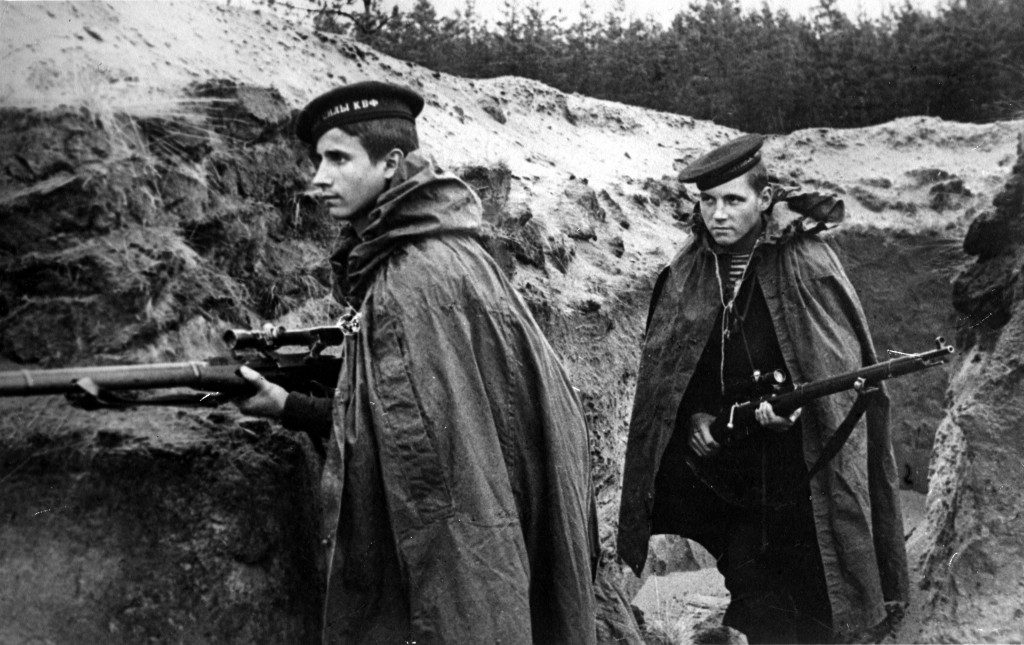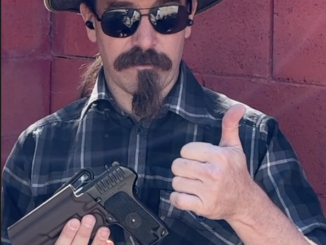
Soviet marines from the Baltic Fleet ashore at Leningrad, armed with PEM 91/30 sniper rifles.

Reader Ruy has sent us this great photo of a very unusual gun in action in the Spanish Civil War – a Maxim-Tokarev “light” machine gun.

My holster and mag carrier in this match are made by BattleGnome Solutions in Slovenia, and available worldwide exclusively from the Polenar Tactical web store: https://polenartactical.com/shop/holsters/1363-tt-holster-bgs.html I was talking to the guys who operate BattleGnome […]

Russia (or the USSR, for these purposes) had an early self-loading rifle in the 1916 Federov, but it was not a satisfactory combat weapons, for several reasons. The Soviet military held a number of trials […]
© 2025 Forgotten Weapons.
Site developed by Cardinal Acres Web Development.

I don’t know if they were mainly worn just for propaganda shots, but every time I seem them I can’t help thinking that the Soviet marines got stuck with the worst combat uniform of WWII. (that said I can understand how in dire circumstances would mean they were rushed into combat in their shipboard uniforms without a chance for a proper refit- it’s just always struck me as a little odd)
Sniping is an interest to us all.
I note that the range and variety of snipping rifles have changed radical from the US Civil War to now.
I have read that many of the greatest shots were done with US made civil war period guns, such as the sharps.
Wonder what the advantage is for the new guns over the old guns, besides they are smokeless.
I would think a long barreled scoped Sharps could shoot as good as those new plastic guns???
Assuming it was using modern day power.
Just wondering.
I suspect that most of the change resulted from going to war with what you have. I have read that german sniper rifles were rifles that were simply pulled off the assembly line and fitted with telescopic sights. From what I have read, the same was true with most other services and nations. Some made special attempts to use the best for sniping, but all used some variation of the current service rifle. That didn’t change until the last 30 years or so.
We certainly have bullets with better aerodynamics than pre 1900, http://www.border-barrels.com/articles/art1.htm
these better aerodynamics allow bullets to:
retain their velocety and energy better at long ranges,
to minimise their “flight” times, meaning less lead for hitting a moving target,
and a flatter trajectory, meaning less compensation (and chance of error) for bullet drop.
we also have much better optics now, including second and third gen image intensifiers and solid state intensified sensors.
That said, the skills of the man doing the stalking and taking the shot are still the most important part.
Not to mention passive infra-red imaging such as FLIR that makes it much harder for the enemy to camouflage his vehicles, equipment and personnel since the thermal differential signature of any object or subject will still be detectable ( although there are camouflage systems in service designed to mask thermal signatures to some degree or other ).
You’re absolutely right about the basics, though. The sniper is still the most vital single factor ; all other components, no matter how technologically advanced, are only aids to the person behind the trigger.
The Soviet Navy also had a specific landing party uniform, but it was hardly issued in the early stages of the war. It was basically a version of the normal infantry combat uniform, with just specific naval rank and insignia added. Accordingly, the officers had a khaki version of the naval peaked cap; as for the rank and file, they had a khaki cover for their sailor peakless caps: it was a rather unusual item, but it fulfiled the ned for differentiation vis-a-vis normal RKKA infantry.
@ R. Aballe: Thanks, I’d seen pictures of the specific landing party uniform, I’ve just seen alot more of them in the sailor uniform which I’d always found a bit odd.
@ Earl Liew: Not disputing that they had a formidable reputation, more feeling sorry for them being stuck with bad kit
Sorry for the typos in the above post… I am trying to get usedto type on my smartphone keyboard…
I’ve seen some photos of Soviet Marines in action. They wore the same uniform, including the funny hats.
Well, I will send Ian a photo of Soviet marines, taken later in the war, depicting the uniform and the specific items I mentioned.
The soviet marine infantery still uses this litle field like combat uniform
Peculiarities of uniform aside, the Soviet Marines were, like their counterparts elswhere, a very tough and competent bunch, definitely worthy of respect.
Good one, Ian. Not the marines I was expecting!
The men of the Soviet Naval Infantry in WWII were not Marines as they are in the U.S., but sailors from the fleet who were formed into land combat units to make up for losses in the regular army. That is why you see so many photos of Naval Infantrymen in sailors’ uniforms. Later in the war, they received infantry-style combat uniforms and helmets. Equipment-wise, they used the same load-bearing equipment and weapons as their land-based counterparts. A peculiarity of the Naval Infantrymen that were equipped with rifles was to wrap a 250-round Maxim belt around their torsos to carry more ammunition.
I’m also a painter of military miniatures…Young Miniatures has a great 1/10th scale bust of a Soviet ‘Black Devil’ ca. 1943 – ’45…an excellent study in black for painters.
CB in FL
A link to the Young Miniatures Black Devil bust:
http://www.young-miniatures.com/gallery/Lee%20Amey/Lee%20Amey-YM1822-1.html
CB in FL
Russian would say: “spasoben do morskoy sloozhby” (fit for service at sea):=))). Good work Chris!
Greetings to all on discussion!
@ Chris Brosnahan :
Thanks for the Young Miniatures link — quite authentic and highly-detailed. They managed to capture the hard facial expression one would expect of combat-experienced Soviet Marine.
In addition, the 250-round Maxim belt that Big Al was referring to is evident. Very nice!
@ Chris and Earl: plus the traditional pea coat and a TT 33 tucked beneath the Maxim belt.
Great catch about the pea coat and TT-33. Thanks!
Years ago, I read a good book about Soviet amphibious raiding operations in Europe. Soviet Naval Infantry formations did a lot of successful sabotage and prisoner snatch operations in the early days when everything else was going horribly wrong. As I recall, a lot of this went on in the Norway and Finland theaters.
Hi, Chris :
Do you remember what the title of the book was? I’d love to get a copy if it’s still available. Thanks in advance!
I read several of them around the same time. I’d have to dig for it. It might be “Over the Volcano”. I forget the author’s name. If that’s the right book, it starts out with the author’s service in the Spanish Civil War and the creation, then elimination of pre-planned partisan operations and pre-positioned partisan weapons and supplies in the Soviet Union, on Stalin’s whim.
It’s actually “Over the Abyss” by Ilya Grigorevich Starinov.
Chris, thanks a lot for taking the time and making the effort to respond to my request. Your help is very much appreciated.
It’s a very interesting book, as are a lot of the other candid books published after the war.
It’s got to be tough to have nearly as much risk of being shot (for not much reason) by your own side as the enemy.
Vasily Zaytsev was a sailor, attached to the army at Stalingrad. One of a group of sailors assigned that way. Supposedly, they wore their striped dickeys under their army tunics to ‘honor’ their original status, and a number of them became elite snipers.
Thanks for sharing this.